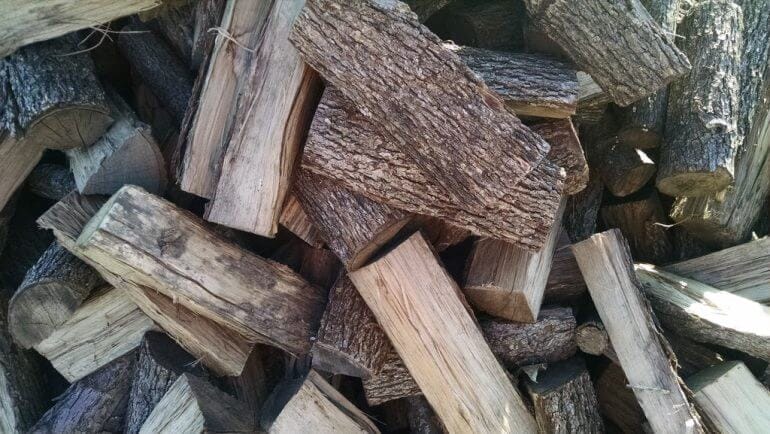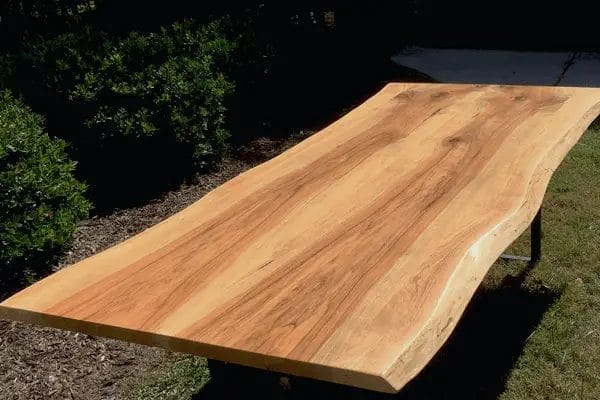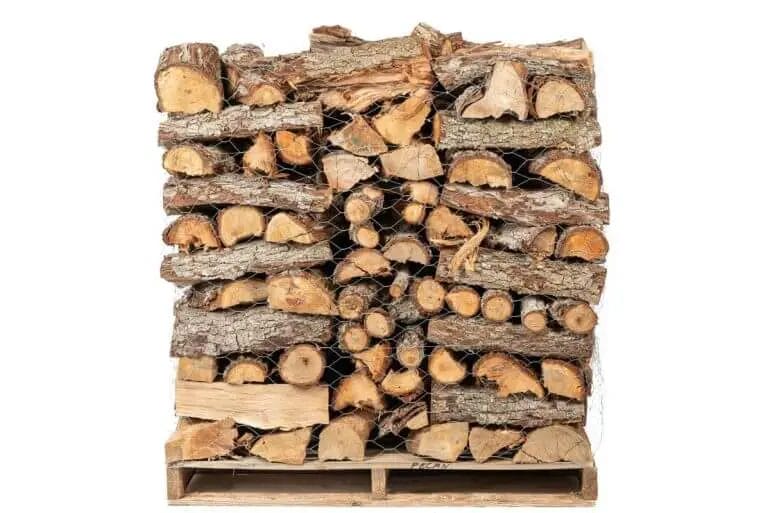Pecan wood is known for its beautiful and distinctive appearance. It features a light to medium brown color with occasional darker streaks, giving it a unique and eye-catching grain pattern. The wood has a smooth texture and a natural luster that adds a touch of elegance to any project. Whether used in furniture, flooring, or cabinetry, pecan wood provides a warm and inviting aesthetic that complements both traditional and contemporary styles.

Unveiling the Beauty: A Closer Look at the Grain Patterns of Pecan Wood
When it comes to woodwork, pecan wood is a popular choice due to its stunning grain patterns and remarkable durability. The unique characteristics of pecan wood make it a sought-after material for furniture, flooring, and various other woodworking projects. In this section, we will delve into the intricate details of pecan wood’s grain patterns, allowing you to fully appreciate the beauty it offers.

1. Straight Grain
One of the most common grain patterns found in pecan wood is the straight grain. This pattern showcases parallel lines running vertically along the length of the wood. The straight grain provides a clean and sleek appearance, making it ideal for contemporary or minimalist designs. Pecan wood with a straight grain pattern is often used in flooring, cabinetry, and paneling.
2. Curly Grain
The curly grain pattern is a true testament to the uniqueness of pecan wood. It is characterized by wavy and swirling patterns that create a stunning visual effect. The curls in the grain give the wood a three-dimensional appearance, adding depth and dimension to any woodworking project. Curly grain pecan wood is highly sought after for decorative pieces, such as ornate furniture, musical instruments, and custom carvings.
3. Figured Grain
Figured grain pecan wood is a term used to describe wood with irregular and interesting patterns. This grain pattern may consist of various elements, such as waves, knots, burls, or bird’s eye figures. Figured grain pecan wood is highly prized for its distinctive and eye-catching appearance. It is commonly used in high-end furniture, as well as for specialty items like turned bowls and veneers.
4. Cross Grain
The cross grain pattern in pecan wood is created when the growth rings of the wood intersect the surface at an angle. This pattern often results in a visually striking display of contrasting lines and colors. Cross grain pecan wood is commonly used in architectural elements, such as doors, window frames, and trim work. It adds a touch of elegance and sophistication to any space.
5. Spalted Pecan
Spalting refers to the natural discoloration and decay that occurs in wood when it is infected by fungi. When pecan wood undergoes spalting, it creates unique and intricate patterns that can range from black lines to vibrant colors. Spalted pecan wood is highly valued for its artistic appeal and is often used in crafting one-of-a-kind furniture pieces, decorative accents, and custom woodworking projects.
In summary, the grain patterns of pecan wood are what make it truly exceptional. Whether it’s the clean lines of the straight grain, the mesmerizing curls of the curly grain, or the captivating figures of the figured grain, pecan wood offers a wide array of options for woodworking enthusiasts and professionals alike. The unique characteristics of pecan wood grain patterns add depth, character, and visual interest to any project, making it a top choice for those seeking both beauty and durability.

The Colors of Pecan Wood: From Light Honey to Rich Amber Tones
Pecan wood is prized for its beautiful colors that range from light honey to rich amber tones. These natural hues add warmth and character to any space, making pecan wood a popular choice for furniture, flooring, and cabinetry.
One of the most distinctive features of pecan wood is its variation in color. Each piece of pecan wood may have different shades and patterns, creating a unique and visually appealing look. The light honey tones are often found in younger pecan trees, while the rich amber tones develop as the tree matures.
The light honey color of pecan wood brings a bright and airy feel to any room. It adds a touch of warmth without overpowering the space, making it perfect for smaller rooms or spaces with minimal natural light. This light hue also pairs well with a wide range of interior styles, from traditional to modern.
On the other end of the spectrum, the rich amber tones of pecan wood exude a sense of elegance and sophistication. The deep, warm color creates a cozy and inviting atmosphere, making it ideal for living rooms, dining areas, or bedrooms. The richness of the amber tones adds depth and character to the wood, making it a focal point of any space.
The color variations in pecan wood are not only visually appealing but also tell a story of the tree’s growth and maturity. As a pecan tree ages, it develops a darker heartwood, which contributes to the rich amber tones. This natural aging process adds a unique charm to pecan wood furniture and flooring, showcasing the beauty of nature’s craftsmanship.
When using pecan wood in interior design, it’s important to consider the overall color scheme of the room. The light honey tones of pecan wood pair well with neutral colors such as white, beige, or light gray. This combination creates a soft and timeless appeal, allowing the pecan wood to take center stage.
For those who prefer a more dramatic look, the rich amber tones of pecan wood can be complemented with deeper shades such as navy blue, forest green, or charcoal gray. This contrast creates a captivating and luxurious atmosphere, perfect for those who want to make a bold statement with their interior design.
In summary, the colors of pecan wood range from light honey to rich amber tones, offering a wide range of options for interior design. Whether you prefer a bright and airy feel or a rich and luxurious atmosphere, pecan wood can add warmth and character to any space. Its natural color variations and unique aging process make it a truly special material for furniture, flooring, and cabinetry.

4. Evaluating the Density and Hardness of Pecan Wood: A Guide for Woodworkers
Pecan wood is a popular choice among woodworkers due to its rich color and beautiful grain patterns. However, before starting a woodworking project with pecan wood, it is important to evaluate its density and hardness. This guide will provide you with essential information on how to assess the quality of pecan wood for your woodworking projects.
Density:
The density of wood refers to the weight of a specific volume of wood. It is an important factor to consider, as it determines the strength and durability of the final product. Pecan wood is known for its high density, making it a sturdy choice for furniture, flooring, and other woodworking applications.
There are several methods to evaluate the density of pecan wood:
- Water Displacement Method: This method involves measuring the weight of an object before and after it is submerged in water. By calculating the difference in weight, you can determine the density of the wood. The higher the density, the more compact and solid the wood is.
- Grain Pattern: The grain pattern of pecan wood can provide visual indicators of its density. Tight and closely spaced grains suggest high-density wood, while wider and more open grains indicate lower density.
- Weight: Simply weighing a piece of pecan wood can give you a general idea of its density. Heavier wood tends to be denser and harder.
- Professional Tools: Experienced woodworkers may use specialized tools such as a densitometer or moisture meter to measure the density of pecan wood more accurately. These tools provide precise readings and are recommended for professional use.
Hardness:
Hardness is another important characteristic to evaluate when working with pecan wood. Hardness refers to a wood’s resistance to indentation or wear. Pecan wood is generally considered to be moderately hard, falling between the hardness of oak and hickory.
There are a few methods to assess the hardness of pecan wood:
- Janka Hardness Test: The Janka hardness test is a common method used to measure the hardness of wood. It involves measuring the force required to embed a steel ball into the wood. The higher the Janka hardness rating, the harder the wood. Pecan wood typically has a Janka hardness rating of around 1820 pounds-force (lbf).
- Scratch Test: A simple scratch test can also be performed to assess the hardness of pecan wood. Using a sharp object such as a knife or screwdriver, attempt to make a scratch on the wood’s surface. If the wood resists the scratch, it is considered to be harder.
- Comparative Testing: By comparing the hardness of pecan wood with other known hardwoods, such as oak or maple, you can get a sense of its relative hardness. If pecan wood feels harder than these woods, it is likely to have good hardness characteristics.
In summary, evaluating the density and hardness of pecan wood is essential for woodworkers to ensure the quality and suitability of the wood for their projects. By using methods such as water displacement, observing grain patterns, weighing the wood, or utilizing professional tools, you can assess the density of pecan wood effectively. Similarly, by conducting a Janka hardness test, scratch test, or comparative testing, you can determine the hardness of pecan wood. Armed with this knowledge, you can confidently select and work with pecan wood for your woodworking endeavors.
Notable Uses of Pecan Wood: From Furniture to Flooring
Pecan wood, known for its beautiful grain pattern and durability, has been used in various applications throughout history. From furniture to flooring, this versatile wood has proven to be an excellent choice for both aesthetic and functional purposes. Let’s explore some of the notable uses of pecan wood.
Furniture
One of the most common uses of pecan wood is in the creation of furniture. The rich, warm tones of the wood add a touch of elegance and sophistication to any piece. Pecan wood is often used to craft dining tables, chairs, and cabinets. Its durability ensures that furniture made from pecan wood will stand the test of time.
Furthermore, pecan wood is highly resistant to warping and shrinking, making it ideal for furniture that will be exposed to different environmental conditions. Its dense structure also allows for intricate carving and detailing, making each piece of pecan wood furniture a true work of art.
Cabinetry
Pecan wood is a popular choice for cabinetry due to its strength and durability. Kitchen cabinets made from pecan wood not only look stunning but also offer long-lasting functionality. The wood’s natural resistance to moisture and humidity makes it suitable for areas prone to high humidity, such as kitchens and bathrooms.
Additionally, pecan wood’s natural variations in color and grain pattern add depth and character to cabinetry, creating a unique and eye-catching aesthetic. Whether you prefer a modern or traditional look, pecan wood cabinetry can complement any design style.
Flooring
Pecan wood flooring is highly sought after for its beauty and durability. The wood’s rich, reddish-brown hue and unique grain patterns create a visually appealing flooring option that can enhance any space. Whether you’re looking to add warmth to a cozy bedroom or elegance to a formal dining room, pecan wood flooring is a versatile choice.
Furthermore, pecan wood is known for its strength and resistance to wear and tear. It can withstand heavy foot traffic and is less likely to scratch or dent compared to other hardwood flooring options. With proper maintenance, pecan wood flooring can last for generations, making it a wise investment.
Smoking and Grilling
Aside from its aesthetic and functional uses, pecan wood is also highly valued in the culinary world. The wood’s smoky flavor adds a unique taste to grilled and smoked meats. Pecan wood chips or chunks are often used in smokers and grills to infuse a delicious smokiness into the food.
Many barbecue enthusiasts consider pecan wood to be one of the best woods for smoking due to its mild yet distinct flavor. It pairs well with a variety of meats, from poultry to pork, and can elevate the taste of your favorite dishes.
In summary, pecan wood is a versatile and valuable material that is utilized in various industries. From furniture to flooring, cabinetry to culinary applications, pecan wood’s beauty, durability, and unique characteristics make it an excellent choice. Whether you’re looking to enhance the aesthetics of your home or elevate your cooking skills, pecan wood is a notable option to consider.
FAQs
What does pecan wood look like?
Pecan wood is typically light to medium brown in color, with a straight grain pattern. It has a smooth texture and a natural luster. The wood may also feature darker streaks or knots, adding character to its appearance.
How long does pecan wood take to season?
Pecan wood typically takes about 6 to 12 months to properly season. It is important to allow the wood to dry completely before using it for woodworking or burning in a fireplace or stove. Seasoning helps to improve the wood’s stability and burn efficiency.
Can pecan wood be used for smoking food?
Yes, pecan wood is excellent for smoking food. It imparts a sweet and nutty flavor to meats, making it a popular choice among barbecue enthusiasts. Pecan wood pairs well with a variety of meats, including pork, poultry, and beef.
Conclusion
In conclusion, pecan wood is a beautiful and distinctive type of wood that can add a unique touch to any project. Its appearance is characterized by rich, warm tones ranging from light to dark brown. The wood has a straight grain pattern with occasional knots and burls, which further enhance its visual appeal. Pecan wood is known for its durability and strength, making it a popular choice for furniture, cabinetry, and flooring. Its natural beauty and versatility make pecan wood a favored option among woodworkers and homeowners alike.